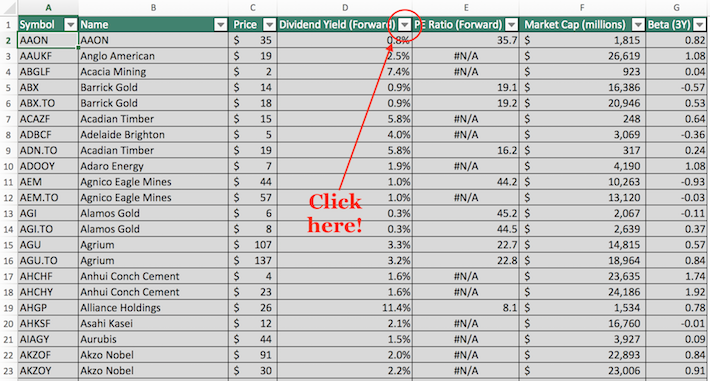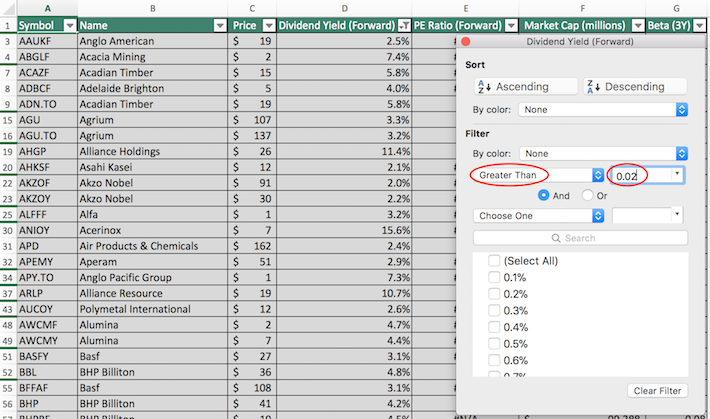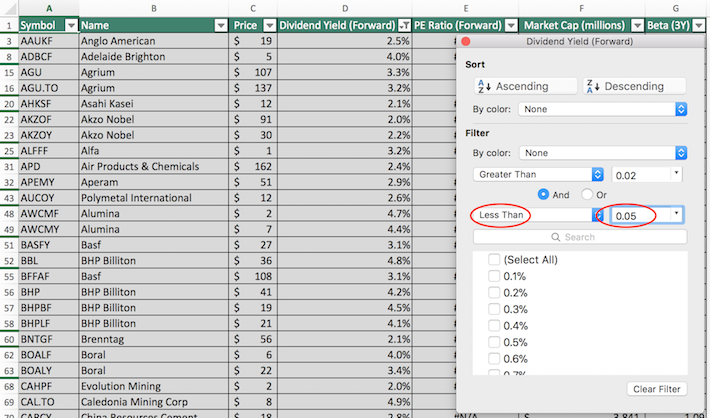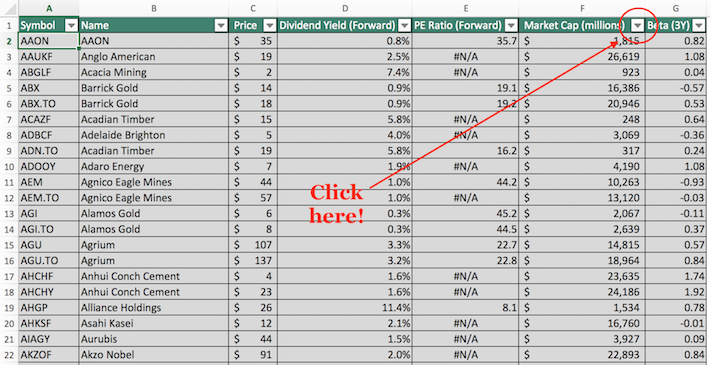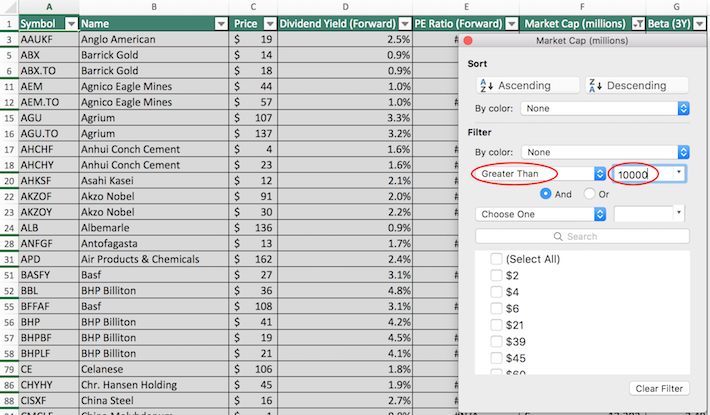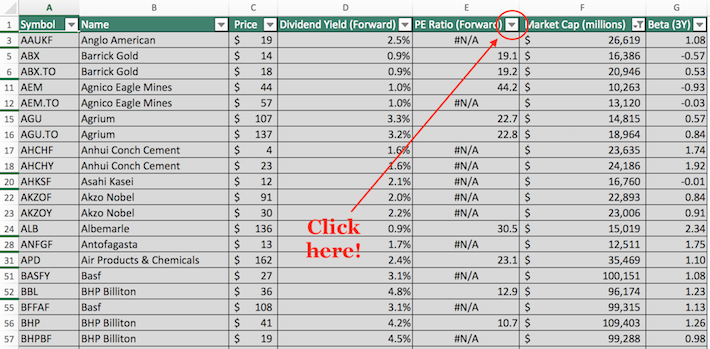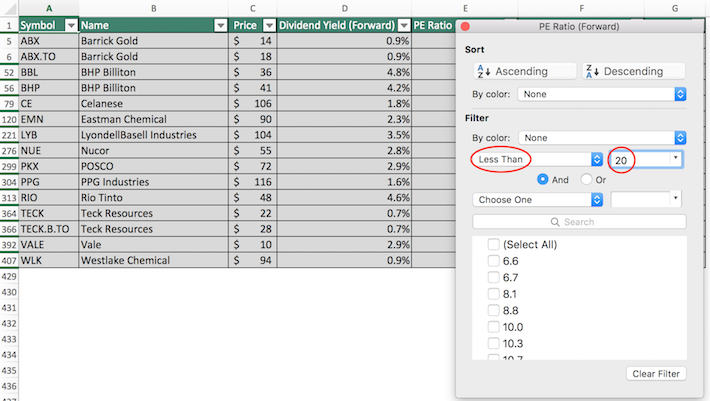Data updated daily
Constituents updated annually
Article updated on October 18th, 2024 by Bob Ciura
The materials sector is a fundamental component of the worldwide economy.
Virtually everything we use in our day-to-day lives relies on ingredients manufactured and distributed by materials stocks. Accordingly, the materials sector could be a promising place to look for high-quality investment opportunities.
With that in mind, we’ve compiled a list of all 83 materials stocks (along with important investing metrics like price-to-earnings ratios and dividend yields) which you can download below:
The stocks in our materials list were derived from these sector ETFs:
- iShares U.S. Basic Materials ETF (IYM)
- iShares Global Basic Materials ETF (MXI)
Keep reading this article to learn about the benefits of investing in materials stocks.
How To Use The Materials Stocks List To Find Investment Ideas
Having an Excel document that contains the company names, stock tickers, and various financial data points for all dividend-paying materials stocks can be very useful.
This document becomes far more powerful when combined with a fundamental working knowledge of Microsoft Excel.
With that in mind, this section will demonstrate how to implement two actionable investing screens to the already-useful materials stocks list.
The first screen that we’ll implement is for materials stocks with high dividend yields. More specifically, we’ll screen for materials stocks with high dividend yields between 2% and 5% (since many stocks with yields above 5% are at risk of experiencing a dividend cut, particularly in the cyclical materials sector).
Screen 1: High Yield Materials Stocks
Step 1: Download the material stocks list at the link above.
Step 2: Click on the filter icon at the top of the dividend yield column, as shown below.
Step 3: In the resulting filter window, change the filter setting to “Greater Than” and input 0.02 into the field beside it. This will filter for dividend stocks with dividend yields above 2%.
Step 4: Change the secondary filter setting to “Less Than” and input 0.05 into the field beside it. This filters for dividend-paying materials stocks with dividend yields below 5%.
The remaining stocks in this Excel spreadsheet are dividend-paying materials stocks with dividend yields between 2% and 5%.
The next screen that we’ll implement is for dividend-paying materials stocks with market capitalizations above $10 billion and price-to-earnings ratios below 20.
Screen 2: Large Market Capitalizations, Low Price-to-Earnings Ratios
Step 1: Download the materials stocks list at the link above.
Step 2: Click on the filter icon at the top of the market capitalization column, as shown below.
Step 3: In the resulting filter window, change the filter setting to “Greater Than” and input 10000 into the field beside it. Notice that since the market capitalization column is measured in millions of dollars, filtering for stocks with market capitalizations above “$10,000 million” is equivalent to filtering for stocks with market capitalizations above $10 billion (which is what we’re really looking for).
Step 4: Close out of the filter window by clicking on the exit button (not the “Clear Filter” button which is shown at the bottom of the window). Then, click on the filter icon at the top of the price-to-earnings ratio column, as shown below.
Step 5: In the resulting filter window, change the filter setting to “Less Than” and input 20 into the field beside it, as shown below.
The remaining stocks in this Excel spreadsheet are dividend-paying materials stocks with market capitalizations above $10 billion and price-to-earnings ratios below 20. As you can see, this screen is very exclusive.
You now have a solid fundamental understanding of how to use Microsoft Excel to make the most of this materials stocks database.
The remainder of this article will discuss the merits of investing in the materials sector of the stock market.
How To Invest In Materials Stocks – Beware Of Its Cyclicality
As its name implies, the materials sector – often called the ‘basic materials’ sector – contains companies whose main business is the extraction, processing, and distribution of raw materials. The materials sector includes businesses in the gold, silver, copper, and iron industries.
Importantly, the materials sector does not includes businesses in the oil and gas industries (which fall in the energy sector).
Although not a part of the consumer discretionary sector, the materials sector is indeed highly cyclical. This is because the price of many of its underlying commodities – gold, silver, etc. – are driven primarily by demand. When the economy contracts, construction slows which significantly reduces demand for these materials.
For this reason, investors will not find many basic materials stocks with extremely long histories of raising dividends each year. There are 7 basic materials stocks on the list of Dividend Aristocrats, a group of 66 stocks in the S&P 500 Index that have increased dividends for 25+ consecutive years.
Furthermore, there are just 5 materials stocks on the list of Dividend Kings, an even more exclusive group of 50 stocks with 50+ years of dividend increases.
What does this mean for investors looking to gain exposure to the Materials sector?
Well, it means that the best time to buy materials stocks is during economic downturns when their stock prices drop. After a multi-year bull market, right now is not the best time to buy a diversified basket of materials stocks.
There may still be compelling investment opportunities within the sector. The best way to identify them is by using a quantitative stock screener such as The 8 Rules of Dividend Investing.
Final Thoughts
The materials sector contains interesting investment opportunities for self-directed investors.
With that said, it is not the only sector to hold high-quality stock ideas.
If you’re willing to explore outside of the materials sector in your hunt for appealing stock opportunities, the following Sure Dividend databases contain some of the most high-quality dividend growth stocks around:
- The Dividend Achievers List: dividend stocks with 10+ years of consecutive dividend increases.
- The Blue Chip Stocks List: dividend stocks that are on either the Dividend Achievers, Dividend Aristocrats, and/or Dividend Kings lists.

